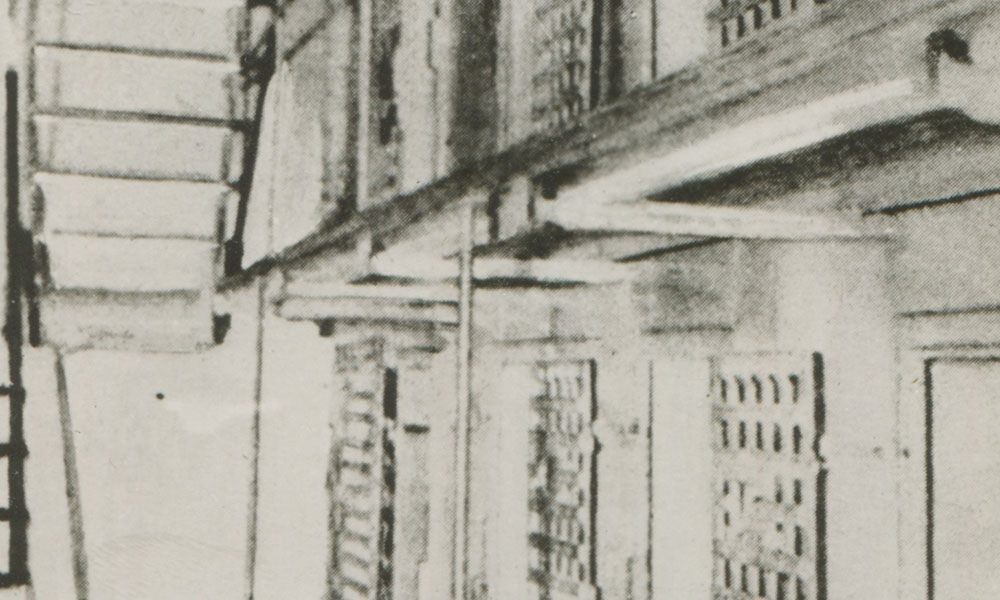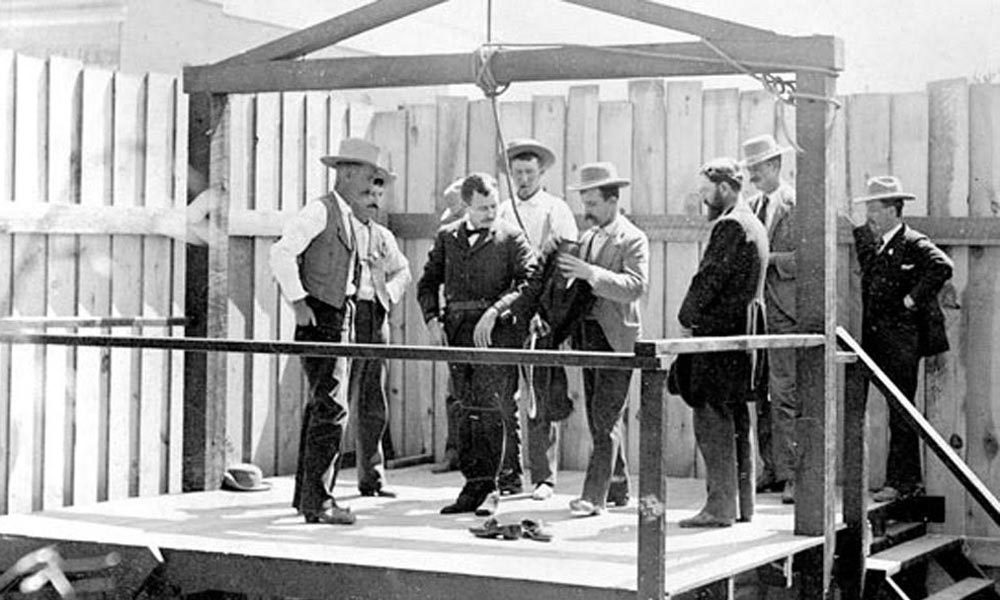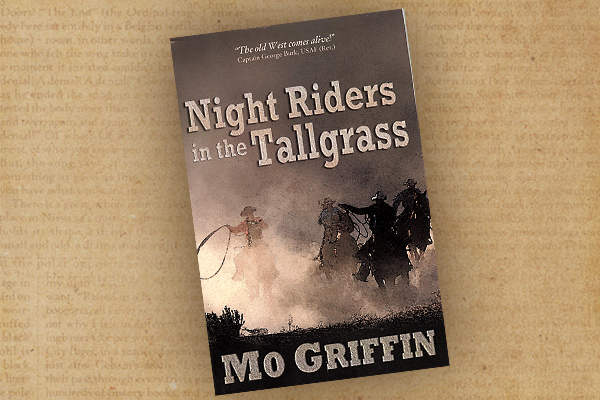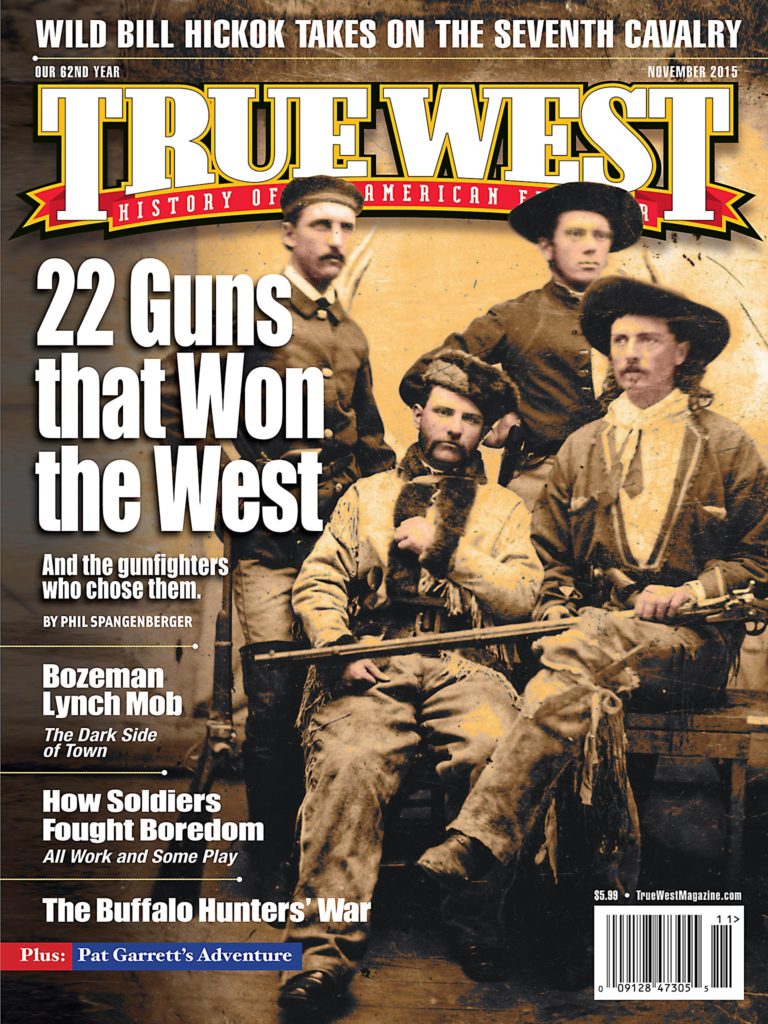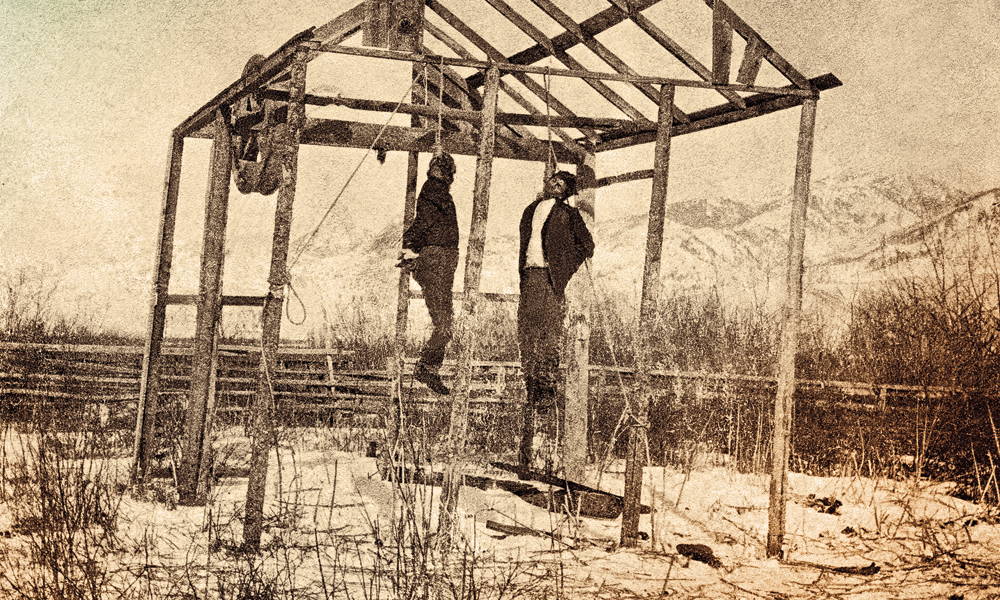
– Courtesy Museum of the Rockies –
When the log battering ram crashed against the jailhouse door, the prisoners inside cowered against the far wall, screaming for help in a desperate hope that someone, somehow, would come and stop the mob. Their cries were in vain, for when the sun rose over Bozeman on the next morning, two men dangled grisly from a slaughterhouse beam.
Bozeman’s Downward Spiral
The lynching of Z.A. Triplett and John W. St. Clair on February 1, 1873, is one of the more ugly examples of Montana frontier vigilante activity. Unlike the more celebrated hangmen of 1864, no Bozeman participants proudly stepped forward to take credit for the deed. Unlike what preceded vigilante action in nearby Bannack and Virginia City, no wave of violence occurred in Bozeman during the first nine years of its existence, as nearby Fort Ellis provided the town with an armed government presence that precluded widespread concerns over lawlessness from either whites or Indians in the Gallatin Valley. Bozeman would walk into its darkest night in disgrace, not as heroic Montana Vigilantes acting in the best interests of their communities.
Established in 1864 as a frontier way station to service the needs of gold-seeking immigrants traveling to the Alder Gulch diggings, Bozeman had been settled by farmers and merchants. The town’s saloons and brothels thrived with Chinese prostitutes catering to the bluecoats who came to town every payday, as well as a smattering of tinhorn gamblers, vagrants and loafers. The petty crime from these unsavory types never rose beyond a periodic nuisance, but that changed in 1872.
A rash of horse thefts in Gallatin County culminated that summer with a successful pursuit of the criminals by Sheriff John C. Guy. After a fierce gunfight, the lawman killed three of the thieves and captured two: Gus Callahan and George “Piute Jack” Clark.
Most residents predicted a swift conviction once the circuit judge arrived in town. “All the thieves were boys well known around Bozeman, some of them well liked,” store clerk Peter Koch wrote in a letter, “ but no mercy is shown a horse thief in this country.”
Yet a mercy of sort was shown when Callahan was allowed out of his cell by Deputy Sheriff Charles Blakeley and escorted downtown in order to pay some debts. While on this errand, Callahan escaped out the back of the Kiyus Saloon, shaking the confidence of many Bozeman citizens in their justice system.
Go Broke, or Go for Broke?
In October, Z.A. Triplett, a 63-year-old trapper who fished for his living in the Yellowstone River, came to Bozeman to sell his catch and spend his earnings on whiskey. He had a late dinner at a lunchroom on Main Street with some friends. After Triplett refused to pay the bill, manager John Gempler took the old man’s overcoat as collateral and summarily pushed him out into the cold night. When Gempler tossed out another drunk, the old trapper plunged a knife into the restaurateur. Gempler lingered until six the next morning before he died. Triplett was arrested.
Bozeman’s citizens were livid; not just over the murder. They were angry about paying the cost of keeping prisoners in jail for weeks while waiting for the circuit judge to arrive and try them. “As a matter of fact our county was almost bankrupt,” Deputy Blakeley wrote. “County warrants had been as low as 25 cents on the dollar.”
The resentment of Bozeman’s taxpayers over keeping prisoners fed was exacerbated when the next crime occurred, on January 30, 1873. John W. St. Clair, popularly known as “Steamboat Bill,” was a mulatto pimp described by the local paper, Bozeman Avant Courier, as a “young man of low instincts, without character, and whose life, so far as known, was passed in the haunts of vice and the purlieus of profligacy.”
When the Chinese prostitute he owned refused to give him 50 cents he needed to treat a friend to a cigar, Steamboat Bill threatened her by pointing his revolver at her head. Intentionally or by accident, the gun went off inches from her face and instantly killed her. Sheriff Guy arrested Steamboat Bill and took him to jail where he remained overnight.
On Friday, January 31, Justice of the Peace Samuel Langhorne held a preliminary hearing at the sheriff’s office. Steamboat Bill’s lawyer argued his client had shot a woman who he depended on for his living, so the gun clearly had gone off accidentally. Langhorne released Steamboat Bill on his own recognizance until the circuit court judge could arrive in March. He told Deputy Blakeley that the town’s taxpayers “would kick if he made cost.”
When Langhorne left the office that afternoon, he heard from townspeople angry about the release. He reversed his decision, telling the deputy, “Here is a [warrant]. Arrest Steamboat Bill and lock him up.”
Blakeley put Steamboat Bill back in jail, but the damage had been done. Blakeley saw townspeople congregating at G.W. O’Dell’s billiard hall. He asked night watchman A.D. McPherson to report any action. McPherson informed him, near 11 p.m., that the men had disbanded and gone to their homes. “I thought that the excitement had blown over, but not so,” Blakeley wrote.
At the End of Their Ropes
On February 1, the streets of Bozeman bustled with the standard Saturday business traffic of farmers buying supplies, soldiers indulging in the town’s fleshpots and merchants busily tending their stores.
“I knew nothing at all of the intention of the vigilantes until about two o’clock [Saturday morning],” shopkeeper Koch wrote his uncle. “It was pretty generally known however, what would be done; but I had been busy all day and heard very little of what was going on.”
About 10 p.m. in the back of Lester Willson’s mercantile on Main Street, Koch had just finished recording the day’s transactions. “…a man came in through the back door and asked me to let him have thirty feet of rope,” Koch recalled. “I got up to cut it off for him, but he acted so strangely that although I had no inkling of what was going on, it struck me all at once what he wanted it for, and I told him that I didn’t think I wanted to sell him any rope that night. He took my refusal very quietly and walked out.”
Later that night, Sheriff Guy heard shouting outside his office and rushed to investigate. Looking north along the creek at the log jailhouse, he saw a crowd of nearly 100 men watching four of their number work a battering ram against the door.
Guy ran to the Northern Pacific Hotel, with hopes that he could recruit a few good men to help him stop the mob. The couple men he found in the hotel’s dining room, curiously unconcerned with his news, protested that none of them had guns. Guy brandished his own weapon to convince the patrons to follow, and they moved stealthily east along Main Street.
Just short of the bridge that spanned Bozeman Creek, two men who had been watching from the shadows of nearby buildings relieved the sheriff of his pistol.
By this time, the men had broken the door to the jail and rushed into the darkened interior. One struck a match and examined the inmates, seeing through the brief illumination the wild-eyed stare of Steamboat Bill and the huddled form of Triplett lying helplessly on the floor. The invaders roughly jerked the old man to his feet, grabbed Steamboat Bill and shoved them outside.
Dead and Done
As the mob dragged their captives east, splashing across Bozeman Creek toward the stockyard and slaughterhouse, Judge Langhorne heard the commotion. He stepped onto Main Street and ran parallel to the retreating mob, calling for them to stop. But the same vigilante sentinels who had prevented the sheriff from interfering also stopped the judge.
The judge returned to his drugstore and convinced a friend to ride to Fort Ellis, three miles distant, to fetch some soldiers. By the time the soldiers arrived, the only people remaining on the scene were two corpses dangling from the crossbeam of a wood frame structure that served as a hoist for slaughtering cows.
An anonymous note arrived at the town’s newspaper office a few hours after Joshua Crissman took his photograph of the hanged men that morning: “Permit us to inform the good people of Gallatin County through the columns of your noble paper, that all action of desperados, such as garotting soldiers, shooting and stabbing white men or Chinese, is now and forever played out in this community. So mote it be. Committee Three Hundred.”
No one was ever convicted for the lynching. The taxpaying hangmen who executed Triplett and St. Clair never admitted their duplicity: they had as much to gain by quickly executing the men as they did by protecting their town from outlaws.
Perhaps the recognition of that ugly reality inspired the publication of another anonymous submission, which closed out the discussion in town a few weeks later. Written by a semi-literate friend of Triplett’s (notice the misspellings), the poem insisted
he kiled A lo down man
for steeling his over cote
and hoo A moung that mid night band
would not fight for that he bought?
and now good by to that old man
God rest his poor old sole
and tak him to that good land
whare the help les ought to go
Professor Kim Allen Scott is the university archivist at Montana State University Library in Bozeman. His most recent book shares Peter Koch’s writings, Splendid on a Large Scale; he is also the author of a biography on U.S. Cavalry Capt. Gustavus Doane and editor of Albert Bishop’s Loyalty on the Frontier, first published in 1863.


